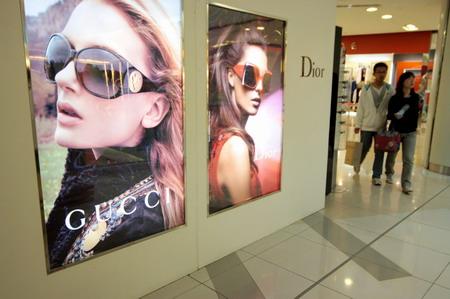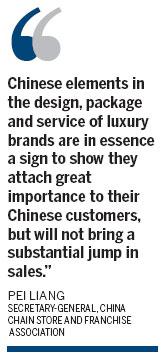
Advertising boards for luxury brands at a department store in Beijing. Bain & Co says China remains the fastest-growing luxury goods market in the world, with a sales volume of 68.4 billion yuan ($10.27 billion) this year. [Photo / China Daily]
Fashionable brands see nation as most profitable market in the worldBEIJING - Dressed in an alluring black dress and sporting a luminous pearl necklace, Holly Golightly stares in wonderment at the world behind the window of Tiffany's emporium on Fifth Avenue in New York City.
It's an iconic image from the 1961 movie Breakfast at Tiffany's that has drawn many young ladies to its jewelry displays. The role of the country girl-turned-socialite was made famous by Audrey Hepburn, who said of the store, it was "the best place in the world, where nothing bad can take place".
Founded by Charles Lewis Tiffany and Teddy Young in 1837, the luxury brand is still going strong, with outlets worldwide from Bogota to Dublin.
Now Tiffany's Chinese fans can appreciate the luxury designer at home after it unveiled its 2011 jewels and diamonds in Beijing in October - the first time the brand has unveiled a major new collection outside the United States.
Although it is a first for Tiffany's, it is part of a trend for global luxury groups. Premium brands are making great efforts to tighten their ties with Chinese clients as they realize that the Middle Kingdom is driving the development of their industry sector, which is experiencing one of the fastest growths in the country.
A study from American consultancy Bain & Co suggested that the recovery of the luxury market was now in full swing with hugely improving sales of high-end goods such as designer handbags and watches.
China remains the fastest-growing luxury goods market in the world, with a sales volume of 68.4 billion yuan ($10.27 billion) and an expected increase of 30 percent this year over last year's takings.
"We aim to let Chinese customers become more familiar with the connotation and history of our brand through this activity, which brings Tiffany's closer to its Chinese buyers," Michael J. Kowalski, chairman of Tiffany & Co, told China Daily.
In the second quarter of 2010, Tiffany's witnessed its fastest growth in China, with a 27 percent increase year-on-year.
"Sales in the Asia-Pacific region, led by China, could increase by a mid-20s percentage for the whole year," Kowalski said.
 Makers of luxury brands that want to get closer to Chinese customers are legion. Reuters reported that the Italian luxury brand Prada said it may launch an initial public offering (IPO) on the Hong Kong stock market if markets recover next year.
Makers of luxury brands that want to get closer to Chinese customers are legion. Reuters reported that the Italian luxury brand Prada said it may launch an initial public offering (IPO) on the Hong Kong stock market if markets recover next year.
Prada has shelved a flotation three times over the last decade and finally chose Hong Kong as the location of its overseas IPO.
During the coming Chinese Spring Festival on Feb 3, the Parisian luxury department store Printemps will offer discounts and organize youngsters wearing traditional Chinese costumes to give traditional red envelopes to Chinese customers to mark the occasion at its 45,000-square-meter location on Boulevard Haussmann.
"We always attach great importance to Chinese customers' sensitivities and we prepare a holiday surprise for our Chinese clients every year," Chief Executive Paolo de Cesare said.
John Galliano, designing director of Dior, together with film director David Lynch and French actress Marion Cotillard, came to Shanghai to advertise Dior's 2010 spring and summer collection earlier this year.
The initiative strengthened the identity of the French fashion house in the city, which is regarded the most modern and stylish place in China.
In September, French fashion label Hermes opened its first boutique for its new brand called Shang Xia (which means topsy-turvy in Mandarin) - a strategy that highlights China's growing importance to the luxury goods company.
The store, an example of minimalist chic, offers clothing, home furnishings, shoes and tableware - a collection made from traditional Asian materials such as bamboo, cashmere and porcelain.
Shang Xia is looking for strong growth in China, a country where Hermes has lagged behind its competitors but which it sees as a principal market.
"The idea is to bring the Hermes philosophy to China, to create a Chinese Hermes," Chief Executive Patrick Thomas told Agence France-Presse.
In December last year, Parisian fashion house Chanel set up a shop in Shanghai where potential customers could get a behind-the-scenes view of the creative process in putting its collections together.
The word Chanel was given a Chinese pictogram that was embroidered on the company's latest collection to give it a distinctive Chinese flavor.
"Chinese elements in the design, package and service of luxury brands are in essence a sign to show they attach great importance to their Chinese customers, but will not bring a substantial jump in sales," said Pei Liang, secretary-general at China Chain Store and Franchise Association (CCFA).
"What Chinese consumers favor are the uniqueness and different culture brought by these European brands," he added.
However, Pei said he believes that as choice expands for Chinese consumers they will be more particular when purchasing luxury goods.
"Some people around me are very familiar with luxury brands of bags, clothes, shoes and watches, but know little about those of household, tableware and musical instruments which can bring them pleasure rather than just show off their spending power," Zhou Yun, a 28-year-old public relations officer, said.
The luxury goods industry is experiencing an experimental phase in China and is discovering that although there is great potential in the market, it is not a top priority among Chinese consumers.
Swiss firm AFG's luxury brand Warendorf kitchens, designed by French designer Philippe Starck, made its debut in Beijing this summer.
"Adding new and versatile elements to the kitchen is the central point to respond to peoples' changing demand for kitchens and provide them with a unique household experience," said Starck.
Warendorf doesn't come cheap. The average Warendorf kitchen is priced at 600,000 yuan, according to Ken Li, assistant manager of the kitchen division at AFG.
Even sports are not immune to the lure of fashion. Beijing Yanlong imported six Ferghana horses from Central Asia to develop the horse trading market in China. Horse racing, a time-honored sport in Western countries, is still in its infancy in China.
However, Zhang Zihan, general manager of Beijing Yanlong, is optimistic about the potential for horse racing in China. "Potential buyers from Shanxi and Guangdong provinces have already showed their interest. Each horse will be priced at more than 5 million yuan during auction," said Zhang.
As an increasing number of wealthy people in China turn to specialist hobbies, horse breeding and horse racing are becoming more popular, following on the heels of yachting, racing cars and golf. It costs about 100,000 yuan a year to care for a Ferghana horse, including feed, veterinary services and training.
Currently there are 20 private horse ranches around Beijing. Chu Wen, owner of Beijing Yihe Stud, started his ranch in the 1990s. After he made a fortune in the property business, he put money into the ranch in Beijing's Yanqing district.
With an investment of more than 15 million yuan, Yihe Stud covers an area of 16.7 hectares and includes standard stables, tracks and also a swimming pool for horses.
"Experiencing a luxury lifestyle involving noble sports will become more common when China's rich people don't only focus on outward dressing to show off their personal fortune and prestige," Pei of CCFA said.
"I consider this a very likely consequence, because what is considered a luxury and fashionable changes frequently for many reasons, especially as 'exclusive' products become more widely purchased and societal values evolve," said Mike Bastin, a professor of brand management at China Agriculture University.
"But the new rich group is still the mainstream of China's luxury goods consumers, so it will take some time for them to change their style of consuming," Pei added.
According to a recent report from Capgemini and Merrill Lynch Wealth Management, China contributed more than 40 percent of sales in the global luxury market and China has 477,000 individuals with investable assets of $1 million or more.This year's Hurun Report on top brands reveals that French and Italian luxury brands continue to dominate the Chinese market.
Also predictable is the finding that Louis Vuitton, Chanel and Gucci remained the "most desirable" luxury brands in China this year.
"Interestingly, the very richest people in the West try very hard to keep their wealth a secret and shun conspicuous consumption. Perhaps the richest Chinese may follow suit," Bastin said.
According to Pei, the newly rich in the West also buy the big names in the luxury goods industry. But he added the caveat: "There won't be so many people infatuated with luxury brands over the next 10 to 15 years. What rich people are most interested in is something that can provide them with mental affluence."





